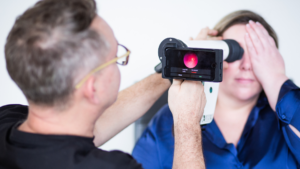IRIS + Risk Adjustment: What Healthcare Providers Need to Know

As the severity of medical conditions increases for patients, so do the costs of treatment. Because of these high costs in the U.S., 38% of people put off medical care. This can lead to worsening patient outcomes, especially for those with underlying, preventable, and treatable medical conditions.
This is true on the healthcare provider side too. Treating sicker patients costs more and the risks are higher. Thus, healthcare providers don’t have the extra incentive to treat patients with more severe medical conditions.
That’s where risk adjustment in healthcare comes in.

What Is a Risk Adjustment in Healthcare?
Risk adjustment in healthcare is the way in which the federal government reimburses healthcare providers through Medicare Advantage. Risk adjustments give healthcare providers a financial incentive to treat sicker patients due to the high costs of providing healthcare to patients with worsening conditions.
Based on Hierarchical Condition Categories (HCC) along with patient demographic factors such as age, gender, disabilities, socioeconomic factors, etc., patients are given a risk score. This risk score is a number or coefficient that tells the Center for Medicare and Medicaid Services (CMS) how much they need to adjust monthly payments to accurately reimburse the medical provider.
By properly reimbursing providers, they have more of an incentive to treat sicker patients and to implement resources to keep people from getting sick i.e. preventative screenings.
Example of a Risk Adjustment in Healthcare
Here is an example of how a risk adjustment could be used in healthcare to determine the reimbursement for a healthcare provider:
Let’s say a Medicare base plan was $100 dollars and a patient had type 2 diabetes mellitus without complications. Their risk score would be .166. The amount from the plan is multiplied by the risk score. From that, the monthly reimbursement for that patient would be $16.60.

Are Risk Adjustments in Healthcare Fair?
Some experts say that because risk adjustment coding relies on past medical data to determine future payments, it may be inaccurate.
Some patients may not use as many healthcare-related services due to barriers to treatment such as transportation, lack of time, accessibility, etc. Because these populations are not receiving treatment, risk adjustment data may not account for the differences in social determinants of health present in those communities.

Thus, risk adjustments need to continually account for the health data of patients’ surroundings to make sure risk adjustment coefficients are fair for people in underserved areas.
Risk Adjustment Models in Healthcare
Recently, CMS announced a change to HCC models for 2024 in Version 28. This healthcare risk adjustment model will:
- Change names of HCC codes
- Increase the number of HCCs
- Change coefficient values
- Change the ICD-10-CM code to HCC mapping
- Remove 2,294 diagnosis codes
- Add 268 diagnosis codes
This model will also be using fee-for-service data from 2018 and 2019 to calibrate more appropriate weights in risk adjustment scores. However, this means that risk adjustment factor scores are likely to decrease overall, projecting a net savings of $11 billion to the 2024 Medicare trust fund.
How IRIS Impacts Risk Adjustment in Healthcare
The IRIS solution impacts risk adjustments for healthcare providers in multiple ways.
When healthcare providers receive sufficient funding from Medicare reimbursement and insurance payors, they can implement more preventative screening measures to detect conditions like diabetic retinopathy earlier on.

Plus, the IRIS teleretinal screening software is camera agnostic, meaning it can meet patients where they are and eliminate barriers to treatment. This, plus earlier detection of sight-threatening eye conditions closes patient care gaps and improves population health as a whole.
By implementing more preventative screenings, healthcare providers can benefit in two central ways.
- By receiving more payouts from insurance payors to invest in more resources for more preventative screenings.
- By improving outcomes for more patients, boosting HEDIS and STAR Ratings
These two benefits create a virtuous cycle that ultimately treats more patients, closes more care gaps, and provides funding for the continuous improvement of patient care outcomes and more profits for healthcare providers.
Choosing the IRIS Solution
IRIS has been leading the fight against preventable blindness for years. Our teleretinal screening solution makes it easy for healthcare providers to meet patients where they are and detect and diagnose diabetic retinopathy before it progresses too far, all in the interest of closing patient care gaps and ending the leading cause of blindness in adults.
To join in on the fight for ending preventable blindness, contact us or schedule a demo. The key to improving patient outcomes and your bottom line is in your hands.
Frequently Asked Questions About Healthcare Risk Adjustments
What Is An Example of a Risk Adjustment in Healthcare?
An example of risk adjustment could be a patient with type 2 diabetes and progressing diabetic retinopathy. Based on the HCC of those conditions, the Medicare plan’s reimbursement payment would change. So, if the HCC of a patient with type 2 diabetes and progressing diabetic retinopathy were .500 and their base monthly payment was $1,000, their reimbursement payment would be $500.
What Are the Three Rs of Risk Adjustment?
The three Rs are risk adjustment, reinsurance, and risk corridor.
What Is an HCC in Risk Adjustment?
An HCC in risk adjustment stands for Hierarchical Condition Category. This model helps assign risk scores to patients based on their prevalent or underlying conditions, demographics, the services they require, and social determinants of health.
How Is a Risk Adjustment Done in Healthcare?
Risk adjustments are done by gathering population health data from the costs of treating patients in the past. Based on that data, conditions are given a coefficient or risk score. That risk score is multiplied by the plan’s monthly payment to determine the reimbursement for the healthcare provider.
What Is The Purpose of Medicare Risk Adjustment?
Medicare risk adjustments are used to determine healthcare costs for treating patients. In addition, they are used to reimburse healthcare providers and incentivize them to treat sicker patients, even if the costs are higher.
SM#159, Rev A
Get started with IRIS today.
Want to know if IRIS is right for you? Schedule a one-on-one consultation with our team. We’re here to help.